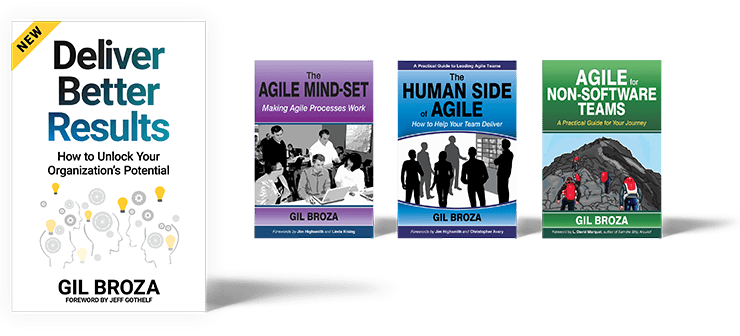Download the book’s supplementary resources
This page includes links to all the supplementary resources mentioned in the book, as well as any additions since the book came out. Feel free to download each and every one. Just right-click and choose “Save As…”.
Chapter 2, Add Value as an Agile Team Leader
Agile Team Leader Responsibilities Snapshot — Use this worksheet to reflect on the 20+ people, product, process, and project responsibilities of the ATL. To what degree does your team need you to perform each one, and how well do you do it? The result is summarized graphically to help you see patterns and prioritize areas for improvements. See a filled-out sample.
How to Have One-on-One Meetings That Matter (New! not mentioned in the book) — Employee-manager meetings, known as “One-on-One”, must take place regularly. Whether you are the employee or the manager, use Gil’s guidelines for effective one-on-one meetings that support growth and build trust.
Chapter 3, Be the Best Leader for Your Team
Effective Team Leader Behaviors — Practice the “Catch Yourself” and “Rehearse a Situation” step-by-step techniques with this worksheet. See a filled-out sample.
Team Trust Tracker — Build the team’s trust in you using this handy tracker, in which you’ll identify trust-building actions, observe follow-through, and note results. See a filled-out sample.
Chapter 4, Select Members for a New Team
Team Member Attribute Matrix — How Agile-friendly are your team members’ qualities and preferences? This easy-to-fill matrix will show you graphically. Use it to identify coachable gaps, and to identify desirable attributes in candidates for the team. See a filled-out sample.
Chapter 6, Cultivate Team Agility
The Evolution of an Agile Team (New! not mentioned in the book) — This is a quick reference to the Tuckman model of team evolution. Showing you what Agile teams experience in each stage, it can help you identify the stage your team’s in, and therefore its likely challenges.
Help Your Team Self-Organize — What is your strategy for helping the team self-organize? What will you do specifically during this iteration? Use this sheet to capture your answers and track your results. Possibly also share your observations with the team as a mirror of their actions. See a filled-out sample.
Collaboration Etiquette (for the A4 format click here) — Increase team member collaboration with these friendly, comics-style posters of the do’s and don’ts of working together. (Note: The book refers to this resource as “pairing booster”, but in the years since writing it, Gil has found better traction by using the word “collaboration” instead of “pairing”.)
Chapter 8, Master Your Communication
Communication Mastery Levels — Make your study and practice of communication mastery more effective with this handy reflection tool. It will show you some gaps and help you see where to focus your energy.
Refactoring Conversation Smells – This reference sheet explains and demonstrates 14 conversation smells (antipatterns) and the precision questions you can use to refactor them.
Chapter 9, Make Meetings Matter
Meeting Leader Cheat Sheet — Like the chapter’s advice regarding meetings? This cheat sheet is a quick reminder of what you need to do before, during, and after a meeting to maximize its effectiveness.
Chapter 10, Champion Your Team
Conditions for Team Success — This checklist will help you ensure that you’re providing your team with everything they need to succeed.
Ten Simple Motivation Catalysts — There is a lot you can do to increase team members’ motivation. This quick list provides 10 simple, easy ways.
Chapter 11, Lead People Through Change
Change Leadership — Whether an upcoming change is the team’s idea or management’s dictum, whether it’s an experiment or a necessity, certain preparations can help reduce the inevitable performance dip and compress the time to successful integration of the change. If you’re part of change leadership, this checklist will help you ensure that you’ve covered all the bases.
Chapter 12, Defuse Resistance
Defuse Resistance — Heading into your next conversation or email, are you expecting push-back? Refer to this quick reminder of the chapter’s techniques, categorized by the push-back you expect.
Chapter 13, Make Continuous Improvement a Reality
Mindful Continuous Improvement — Retrospectives can become repetitive very quickly, and sometimes you need to look at more than process or teamwork. This exercise, which the team can do every few months, has each individual consider their enjoyment — a crucial factor in their engagement, motivation, and contribution.
Chapter 14, Stay the Course
Keep up the Good Work: Ten-Point Team Checkup — Even when your Agile team has been in the “performing” stage for a few months, there is no guarantee that they’ll stay there. Keeping them performing, or correcting setbacks, is highly contextual; it is a people matter more than a methodology matter. Use this quick checkup form to take care of the first order of business: understanding where they are now.


